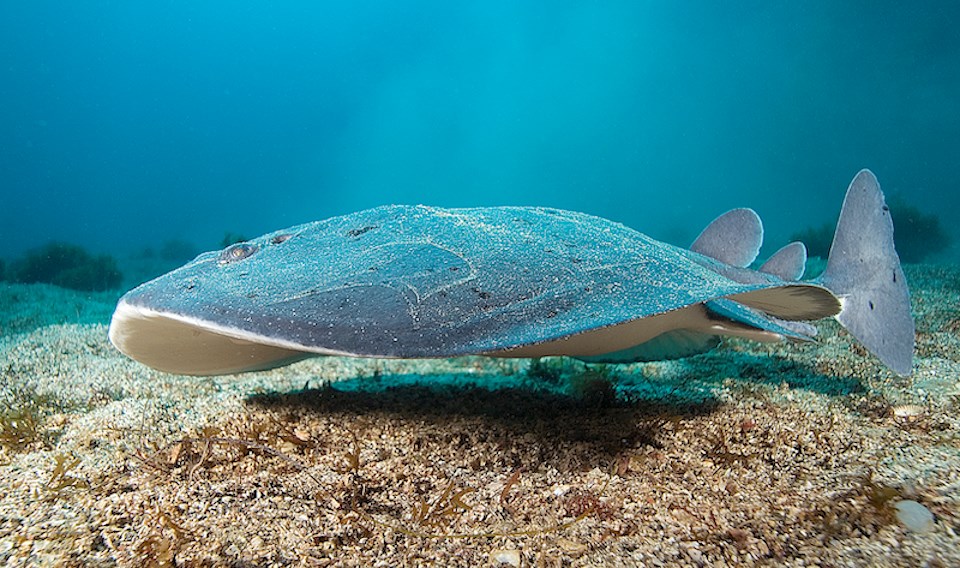Numerous sea creatures call the Pacific Northwest home, prompting excitement from onlookers who observe them in the water. However, ones residing below the surface often go undetected by land dwellers.
Stingrays are related to sharks, although they may not appear as close relatives. With flat bodies and almost angelic-looking pectoral fins, they move through the water by flapping their fins or undulating them like a wave.
Hugely popular nature conservationist Steve Irwin, known as the "Crocodile Hunter," was famously killed by a short-tail stingray - the largest stingray species in the world, with adults growing up to , 14 feet long, and weighing close to 800 pounds.
The massive short-tail ray is only found in the southern hemisphere in the Indo-Pacific. While they can act aggressively when threatened, conflicts with humans are rare, with most divers having peaceful interactions with short-tail rays.
Manta rays are another famous species, known for their graceful swooping motion and jaw-dropping sizes (oceanic rays can grow up to 30 feet long, 23 feet across, and weigh over 6,000 pounds). Their smaller cousin, the devil ray, has a front-facing mouth between its cephalic fins (horn-like fins at the front of their bodies that give them a ).
Numerous ray species pose little to no harm to humans, and, in some cases, may pass undetected by divers, boaters, and swimmers. A couple of such rays are found in Metro Vancouver waters.
Rays observed locally don't reach sizes comparable to giant species but one has a unique feature.
Pacific torpedo ray: An electric fish in Metro Vancouver
Dr. Nick Dulvy is a professor of marine biodiversity and conservation at Simon Fraser University who has studied oceans and their inhabitants for decades. He is an expert advisor on the (SCF), a group dedicated to solving the global shark and ray crisis, and on the . He also served as co-chair of The International Union for Conservation of Nature Red List of Threatened Species (IUCN) SSC (SSG) for over eight years.
Dulvy told V.I.A. that 13 rays inhabit B.C. waters, including 11 that are skates (ones that lay mermaid's purse eggs) and two rays (that give live birth). Only a handful of fish species give birth, including sharks and rays (see slide two).
One of the two ray species spotted locally started appearing more often over the past decade due to rising ocean temperatures...and it isn't the only new fish making its way to local waters.
- Related:
Dulvy says Pacific torpedo rays, also known as Pacific electric rays or by their scientific name, Torpedo californica, are the only electric rays found in the Pacific Northwest but there are over 60 species worldwide.
What you need to know about Pacific electric rays
are elusive, with dark grey to blueish or brown colouring. They have an oval-shaped body and can grow over four feet long; their first dorsal fin is double the size of the second. They can swim to depths of 900 feet and are rarely spotted by locals, as they are solitary and nocturnal. Their preferred habitats are kelp forests and sandy ocean floors.
While they prefer warmer waters, they have been spotted in B.C. as far north as Dixon Entrance.
The local electric fish can also generate "up to " to capture prey or in defence. People should remain cautious around electric rays as they can act aggressively if provoked and an electric shock could incapacitate a diver, according to iNaturalist.
They give birth to litters of 17 to 20 pups and "uterine milk."
Multiple ray, skate, and shark species on the brink of extinction
The IUCN lists the Pacific torpedo ray as a species of , since it is not fished isn't fished in significant numbers. However, many other ray and shark species are under threat of extinction due to overfishing and other threats.
B.C. waters are home to one other ray species, , which is uniform dark purple or blue-green and grows over five feet long, with a long, whip-like tail. This species doesn't produce an electric shock but the cells at its spine's base secrete poison causing exceedingly painful wounds. Since they live in the open ocean, human contact is rare.
Dulvy has spent his career showing people why skates and rays are fascinating, hoping his passion can help preserve numerous species on the brink of extinction. In B.C., skates are fished and exported to other countries, although the Canadian government has stricter regulations. In other countries, fishermen have the power to overfish populations.
Sharks conservation often gets more attention than ray or skate but the ocean dwellers are part of the same family.
"Very often people forget that rays are flat sharks," he notes, adding that sharks have gill slits on the sides of their heads and rays on the bottom.
"In most places in the world, the rays tend to be quite heavily fished. Only in the last 15 years or so have skate fisheries been managed."
Fatalities and injuries from shark incidents with humans are no longer called shark attacks; they are classified as "bites" because sharks don't see humans as prey. They investigate their surroundings with their mounts and, as Dulvy points out, people are more likely to get injured by a vending machine than these apex predators.
The same guidance is true for rays and skates, which patrol the ocean largely unobserved by humans and conflict is rare. Manta rays and other species peacefully swim alongside humans, offering an otherworldly undersea experience.
"They are truly beautiful," the conservationist said.




